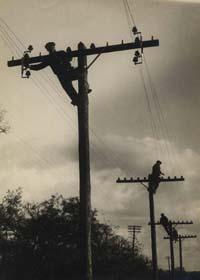When the voice began to spread to kilometers

The US Congress approved in 2002 the Italian-American Antonio Meucci as the real inventor of the phone. But it will be difficult to erase Alexander Graham Bell's footprint in the history of the phone. In 1976, Bell got what Meucci couldn't get: the phone patent.
Bell, a Scottish native, lived in Boston, and the phone began its journey in the Boston area. Surprisingly, the appearance of the telephone did not have much influence at first, especially because in 1876 the communication needs of society met telegraphs. In addition, the most common form of information that came from old was written, and people considered the phone as a toy or a whim.
Thus, in the interurban service it was very difficult to assume the competence of the telegraph. The phone made its hole inside the city. Due to industrialization, the urban population had grown a lot and the telegraph for commercial relations was not suitable, as they had to go elsewhere to send a telegram.
Short chain at the beginning
Bell's invention consisted of a transmitter and receiver joined by a conductor cable --normal copper. The first phones were installed in Boston and nearby cities. Telephone communication was between two specific points, such as a financial office and an office of a politician.
When the number of users increased, however, there was a need for a PBX to connect all together. In this way, the telephone cable of each user would be connected to the central and there the operators would manually make the connection between the lines.
The first PBX opened in 1878 with 21 subscribers in Nueva Haven. We cannot forget that the first employees hired by Bell for this plant were children between 10 and 17 years old. Later, due to complaints filed by subscribers and pressured by legislation protecting children's rights, she began hiring women (paid less than men and had no union rights).

Phone use was not limited to the US. Although at a slower pace, it soon opened to the world. The first PBX was installed in England in 1879, and soon multiplied by many places in the world. In all of them women were regular workers.
More distant dreams
When copper wires ran hundreds of miles, scientists dreamed farther. In order to break the limits of distance, in 1892 an important step was taken: Between Chicago and New York 1,600 kilometers of telephone line were opened.
Unfortunately, that communication proved quite bad. The phone worked quite well at short distances, but the clarity of the word was missing a lot as the space increased.
To solve this, years later, Michael Idvorsky Pupin, professor at Columbia University, took a fundamental step in long-distance communication. He proposed placing coils on telephone lines to improve transmission.
Say and do. In the line between New York and Chicago coils were put on and the success was huge. From then on, the long distance lines were dressed with Pupin coils: The line linking New York and Denver (3,520 km), the underground cable linking Boston, New York, Philadelphia and Washington... And elsewhere in the world they followed the same model.

But the invention of the pupines did not completely overcome the obstacles of the kilometers. What was said at a long distance, besides losing light, lost intensity. Therefore, it was thought to place repeaters or amplifiers along the line to increase the intensity of the voice. Telegraph companies used repeaters since ancient times, but they did not serve telephone lines, as they played the human voice too slowly. After many attempts, they finally managed to design the right repeater or amplifier.
The victory was the sharing of coils and repeaters. In 1956 the first underwater transatlantic cable connecting Scotland and Ternua was installed. Today, the most modern submarine cables traverse all oceans.
First by air, and then underground and water, the phone exceeded the limits of the distance. Not so the economic limit. In the city of Tokyo there are more phones than in the entire African continent. Clearer!
Buletina
Bidali zure helbide elektronikoa eta jaso asteroko buletina zure sarrera-ontzian











